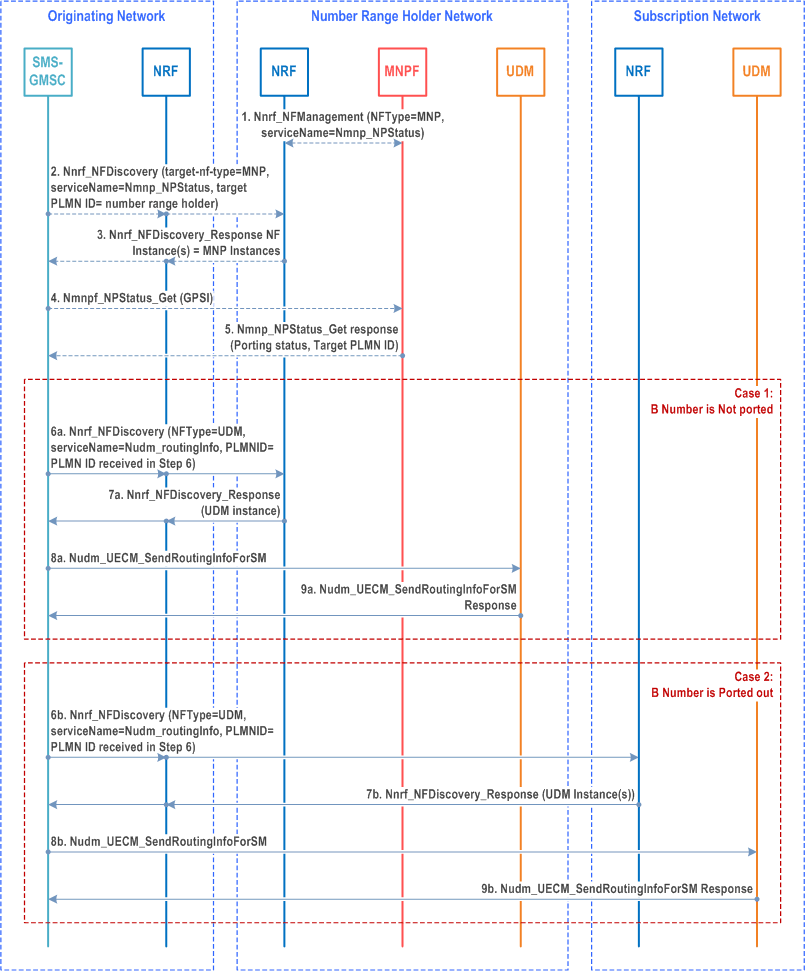Content for TS 23.540 Word version: 18.3.0
1…
4…
5…
5.1.3
5.1.4
5.1.5
5.1.6
5.1.7…
5.1.7.2.3…
5.1.7.3.2
5.1.7.3.3
5.1.7.3.4
5.1.7.3.5
5.1.7.4
5.1.8…
5.2…
6…
5.1.7.2.3 GPSI-to-Subscription-Network resolution triggered by the SMS-GMSC for Indirect routing
5.1.7.3 SCP supports GPSI-to-Subscription-Network resolution procedure
5.1.7.3.1 General
...
...
5.1.7.2.3 GPSI-to-Subscription-Network resolution triggered by the SMS-GMSC for Indirect routing p. 24
When MNP is implemented in a country or number portability domain with indirect routing mechanism, the signalling messages are always routed to the number range holder network, the number range holder then performs a number portability check and forwards the request to the subscription network if the number is ported out. For the case of international SMS termination also indirect routing is applied. In the case of international SMS termination, the originating network is outside the number portability domain and may not have any knowledge of whether number portability is implemented in the country of the recipient GPSI.

Step 1.
If the MNPF is deployed in the Number Range Holder PLMN, the MNPF registers in the NRF of the number range holder PLMN with a new NF Type (e.g. MNPF).
Step 2-3.
The SMS-GMSC should query the local NRF to find the MNPF instance that manages the PLMN ID of the recipients GPSI's subscription network, the local NRF forwards the discovery request to the NRF of the number range holder PLMN.
Step 4.
SMS-GMSC invokes Nmnpf_NPStatus_Get (GPSI) to the MNPF to get the target PLMN ID of the GPSI.
Step 5.
MNPF checks the portability status of the recipient GPSI and responds back with the target PLMN ID.
Step 6-7.
SMS-GMSC shall query the NRF to find the UDM instance serving the target PLMN based on target PLMN ID received in step 6.
Step 8-9.
- For step 7a-8a, if the target PLMN ID belongs to the number range holder PLMN, the local NRF forwards the discovery request to the NRF of the number range holder PLMN.
- For step 7b-8b, if the target PLMN ID belongs to the Subscription PLMN, the local NRF forwards the discovery request to the NRF of the Subscription PLMN.
SMS-GMSC invokes Nudm_UECM_SendRoutingInfoForSM (GPSI) to the UDM of the target PLMN to get the serving node instance for UE. The UDM shall check the registration/reachability flags to determine the potential target nodes and responds to the SMS-GMSC by sending Nudm_UECM_SendRoutingInfoForSM response, in this procedure the SMSF instance Id is included in the response message.
5.1.7.3 SCP supports GPSI-to-Subscription-Network resolution procedure p. 25
5.1.7.3.1 General p. 25
This procedure is used to retrieve the PLMN ID of the recipients GPSI for further discovery of UDM NF profiles for invoking UDM service operation for routing information retrieval. In indirect Communication with Delegated Discovery, the SCP is the service consumer of the GPSI-to-Subscription-Network resolution service in MNPF and routes an SBI message based on GPSI when MNPF is implemented. The SCP shall use the discovery factors (see clause 6.10 of TS 29.500) provided by the SMS-GMSC to determine when to invoke the MNPF resolution, and to obtain the identity (GPSI) of the recipient.
The SMS-GMSC sends routing information retrieval request to the SCP and the SCP uses the PLMN ID as the target PLMN ID in the discovery request towards NRF to discover the UDM NF profiles in the subscription network of the SMS recipient.